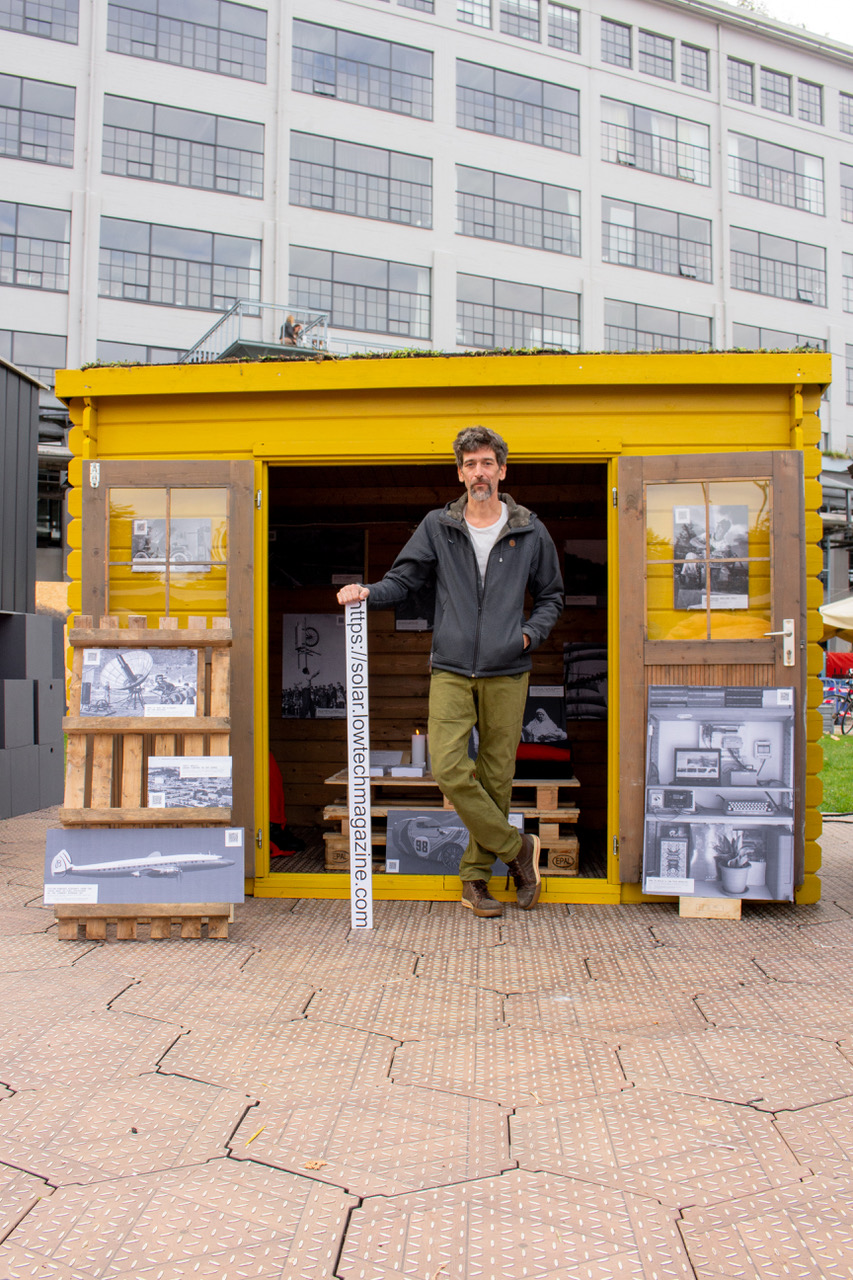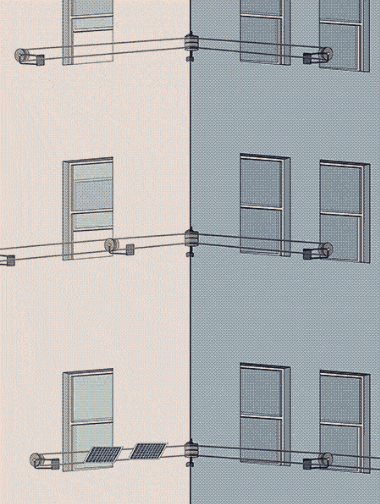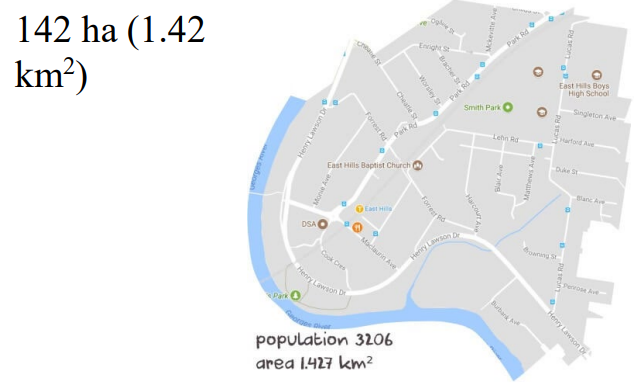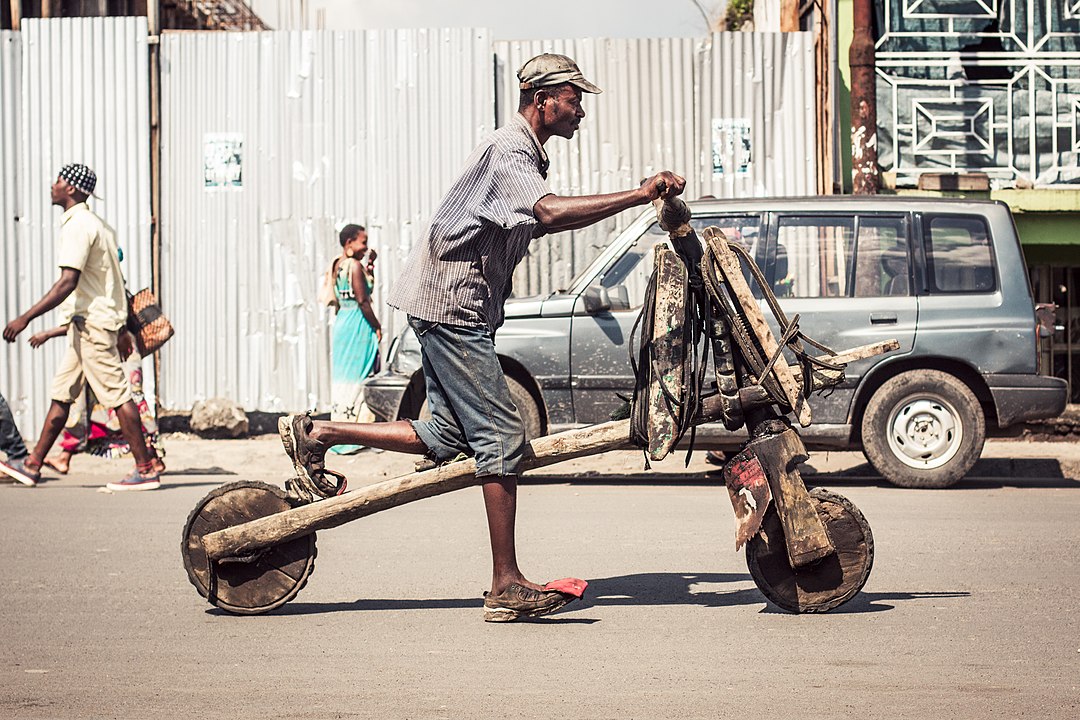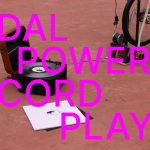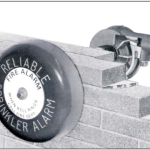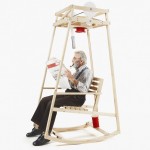Here’s our off-line portal to the solar powered website at the Dutch Design Week in Eindhoven. Designed and built in collaboration with Marie Verdeil. We formed part of Arne Hendriks’ Hara Hachi Bu village, which celebrates the Japanese principle that enough is enough. “Eat until you are 80% full”.
Off-line Portal to Solar Powered Website
This clothesline goes around the corner
Low-tech Magazine featured Jonas Görgen’s mist shower in an earlier article. He did a second graduation project at the Design Academy Eindhoven that is worth mentioning: the clothesline that goes around the corner:
Revive the ol’ clothesline! This pulley system can move objects around the corner of a building. Following (or avoiding) the sun can help with making the most of the momentary weather conditions.
Modern buildings often trap the inhabitants into unsustainable practices such as using a tumble dryer or a large refrigerator. Making practical use of outside spaces of buildings is commonplace around the globe, from clotheslines spanning across streets in Italy to roofs crowded with jugs full of fermenting Kimchi in Korea.
It is not merely about resourcefulness, as these practices become part of the identity of a place.
In a reaction, he writes that “I wanted to think of a possibility to break out of the lifestyle that is dictated by the building in which you live”.
Source: Jonas Görgen.
Technologically utopian solutions rest on narrowly defined system boundaries
Quoted from: Cederlof, Gustav, and Alf Hornborg. “System boundaries as epistemological and ethnographic problems: Assessing energy technology and socio-environmental impact.” Journal of Political Ecology 28.1 (2021): 111-123.
What are the social and environmental impacts of carbon and low-carbon energy technologies in different places and at different times? To answer this question, we are faced with an epistemological dilemma. Before measurement takes place, we need to define where and when the phenomenon we are measuring begins and ends—to define its “system boundaries.” For instance, one liter of semi-skimmed milk, bought in a British supermarket, has an energy content of 380 kcal. However, to think of the milk in terms of energy also evokes the far-reaching social and environmental contexts that bring milk to the market.
Beyond the energy content declared on the milk carton, we can undertake a life cycle assessment (LCA)—expanding the system boundaries—to account for the energy (or the carbon, water, labor, or land) “embodied” in the milk via its production and distribution. We might include the energy content of processed cattle feed, electricity used to run milking machines, cooling tanks, water boilers, and lighting, energy inputs in alkaline and acid detergents, diesel for tractors, and a wide range of other energy technologies used in production.
We might expand the system boundaries further to account for the fuels needed to generate the electricity, run the chemical plant, fuel the milk tanker, power the dairy plant, and so on. Arguably, we should also account for the energy expended in the production of the electricity generator, the milking machine, the milk tanker and the tractor, fencing and the batteries storing energy to electrify it. But if an electricity generator and a battery are somehow embodied in a liter of milk, we have culturally come far away from what we normally understand milk to be. Where, then, should we draw the system boundaries around an object in order to gauge its social and environmental impact?
Flying Only with the Heat of the Sun
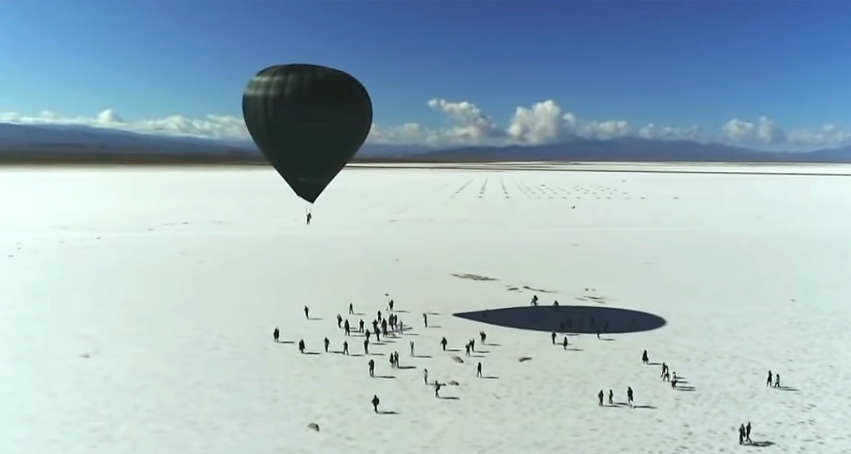
If you picture a flying machine, you probably imagine a craft which is heavier than air, somehow kept aloft with wings or propellers. Heavier-than-air flight dominates discourses about aviation. “Sustainable” crafts are designed to be as light as possible (whilst remaining heavier than air), so that they require less energy from whatever renewable source they use for lift. These machines include human-powered planes such as those using pedals to rotate a propeller. Lighter still are kites and gliders, which remain heavier than air, but rely on air resistance and lighter air around them to fly.
Less discussed are flying machines which are lighter than the air they fly through because the weight of their materials and passengers is counterbalanced by the hot air or light gases they contain. [1] Perhaps this is because most of us experience flight in passenger airliners, not Zeppelins. In theory, making lighter-than-air flight sustainable is simple: heat a container full of air with sunlight so that it rises. In January 2020, Leticia Noemi Marqués flew freely in the Aerocene Pacha solar balloon, the first Fédération Aéronautique Internationale certified fully-solar, untethered, manned flight. Previous flights of this kind went uncertified or relied on propane burners or inflation generators [2]. Aerocene Pacha flies on solar energy not from solar panels or batteries but absorbed directly in the envelope (the fabric of the balloon). [Read more…]
Remaking Suburbia
Quoted from: Trainer, Ted. “Remaking settlements for sustainability: the Simpler Way.” Journal of Political Ecology 26.1 (2019): 202-223.
In view of the global resource and ecological situation, per-capita resource consumption rates in the rich world probably need to be reduced by 90%. This can only be done if there is a “de-growth” transition to some kind of Simpler Way centered on mostly small, highly self-sufficient and self-governing communities in control of local economies within a culture that is not focused on material wealth.
It is not surprising that the viability of such a vision is typically regarded as implausible. The aim of this study is to show that normal outer city suburbs could be restructured along the lines required to cut global impacts by the necessary amount, while improving the quality of life. Data on typical Australian consumption rates, food production yields, suburban geographies, etc. is used to estimate the achievable reductions.
The theoretical conclusion that such reductions could be made aligns with a study of the Dancing Rabbit Eco-village in northeast Missouri. Heavy cuts in resource consumption cannot be made without extreme change in economic, political, settlement and cultural systems.
The Chukudu is a cargo scooter built entirely from wood
Image: Lahminewski Lab, CC BY-SA 4.0.
From the Wikipedia page, which summarizes and links to all sources that are available online:
The chukudu is a two-wheeled handmade vehicle used in the east of the Democratic Republic of Congo. It is made of wood, and is used for transporting cargo. The chukudu generally has an angular frame, two small wheels (often of wood, sometimes wrapped with rubber), handlebars, and a pad for the operator to place their knee on while propelling the vehicle with their leg. On a descent, the rider stands on the deck like a kick scooter. On flat ground, the rider can put one knee on the deck and push the ground by the other foot like a knee scooter. Rubber mud flaps and shock absorber springs may be added.
In Goma, where chukudus form the “backbone of the local transportation system”, chukudus are made of hard mumba wood and eucalyptus wood, with scrap tires for wheel treads. These chukudus take one to three days to build, and last two to three years. The most commonly used size is about six and one half feet long, and carries a load of 1000 lbs. However, the largest chukudus can carry up to 800 kilograms of weight.
A small chukudu can be built in about three hours, using dimensional lumber and materials available in a hardware store. The chukudu is customizable to carry different types of cargo. To haul firewood some chukudus have a hole drilled in the middle of the sitting deck, and the operator can insert a stick to hold firewood in place. Others have a large basket to carry various loads.
DIY.
Thanks to Spencer Cappallo.
